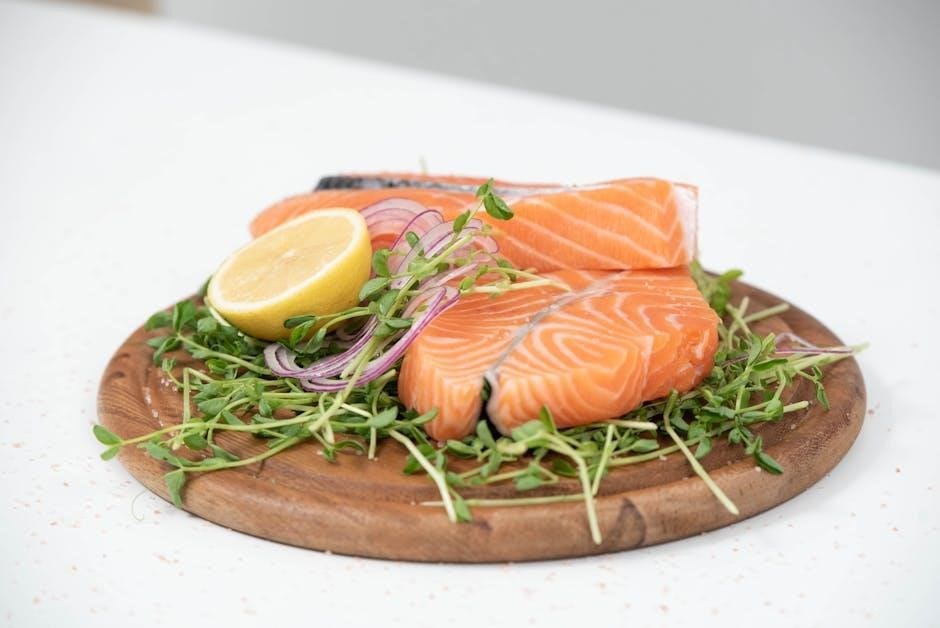The pescatarian diet combines elements of vegetarianism with the inclusion of seafood and fish, offering a balanced approach to nutrition while avoiding meat and poultry.
1.1 What is a Pescatarian Diet?
A pescatarian diet is a vegetarian diet that includes fish and seafood while excluding meat and poultry. It emphasizes plant-based foods, dairy, and eggs, offering a flexible and balanced approach to nutrition. This diet is ideal for those seeking to reduce their meat consumption without fully adopting a vegetarian lifestyle.
The pescatarian diet is often chosen for its health benefits and environmental impact, as it incorporates protein-rich seafood and avoids high saturated fat foods. It appeals to individuals looking for a sustainable and varied dietary option.

1.2 History and Evolution of the Pescatarian Diet
The pescatarian diet has its roots in early coastal communities that relied on seafood as a primary protein source. The term “pescatarian” emerged in the 1990s, blending “pesce” (Italian for fish) with “vegetarian.” It gained popularity as a middle ground between vegetarianism and omnivory, appealing to those seeking to reduce meat consumption without eliminating it entirely. Over time, the diet has evolved to emphasize sustainability and health, influenced by global cuisines like Mediterranean and Asian diets, which often feature seafood and plant-based meals. Today, it is recognized as a flexible and balanced dietary choice.
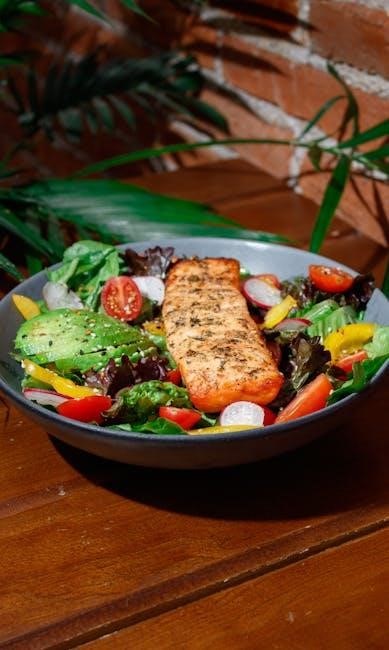
Benefits of a Pescatarian Diet
The pescatarian diet offers improved heart health, reduced inflammation, and higher omega-3 intake from seafood, while its plant-based focus supports environmental sustainability and a lower carbon footprint.
2.1 Health Benefits of a Pescatarian Diet
The pescatarian diet promotes heart health by reducing saturated fat intake and increasing omega-3 fatty acids from seafood, which lower cholesterol and inflammation. It supports brain function, improves blood pressure, and reduces the risk of chronic diseases like diabetes. By avoiding meat and poultry, the diet minimizes exposure to antibiotics and hormones often found in livestock, while the inclusion of fish enhances protein intake and provides essential nutrients like vitamin D and selenium. Overall, it offers a balanced approach that supports long-term well-being and reduces the risk of obesity and cardiovascular conditions.
2.2 Environmental Benefits of a Pescatarian Diet
Adopting a pescatarian diet significantly reduces your environmental footprint. By avoiding meat and poultry, you lower greenhouse gas emissions associated with livestock farming, which is a major contributor to global warming. Sustainable seafood choices help preserve marine ecosystems, while plant-based meals reduce deforestation and water usage. This diet also minimizes food waste by encouraging meal planning and the use of fresh ingredients. Overall, it offers an eco-friendly alternative to traditional diets, promoting biodiversity and reducing carbon emissions, thus supporting a healthier planet for future generations while maintaining nutritional balance.
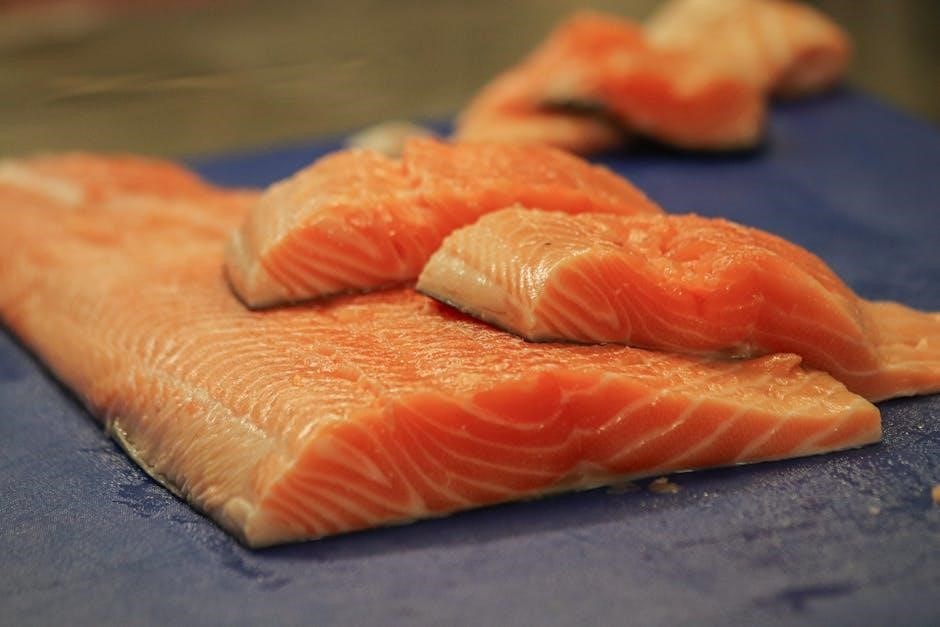
Foods to Eat on a Pescatarian Diet
A pescatarian diet emphasizes seafood, fish, plant-based foods, and dairy. It includes fruits, vegetables, whole grains, legumes, nuts, and seeds, promoting a diverse and nutrient-rich intake.
3.1 Seafood and Fish Options
A pescatarian diet includes a variety of seafood and fish, such as salmon, tuna, shrimp, mussels, and cod. Fatty fish like salmon and sardines are rich in omega-3 fatty acids, while leaner options like tilapia and mahi-mahi provide protein without excess fat. Shellfish, including shrimp, mussels, and clams, are also great sources of nutrients. Wild-caught and sustainably sourced options are recommended for better nutritional value and environmental impact. Incorporating a mix of fish and seafood ensures a diverse intake of essential vitamins and minerals, making meals both nutritious and flavorful. Avoiding processed seafood is key for maintaining a healthy diet.
3.2 Plant-Based Foods and Dairy Products
Plant-based foods form the foundation of a pescatarian diet, including fruits, vegetables, whole grains, nuts, seeds, and legumes. These provide essential vitamins, minerals, and fiber, supporting overall health. Dairy products like milk, yogurt, and cheese are also included, offering calcium and protein. Incorporating a variety of colorful vegetables ensures a broad intake of antioxidants. Whole grains, such as quinoa and brown rice, provide sustained energy. Legumes like lentils and chickpeas are excellent protein sources, while nuts and seeds add healthy fats. Balancing these foods with seafood creates a well-rounded and nutritious diet.
Foods to Avoid on a Pescatarian Diet
Avoid red meat, poultry, and processed foods high in trans fat. Eliminating these reduces health risks and aligns with the diet’s focus on seafood and plant-based options.
4.1 Meat and Poultry
The pescatarian diet explicitly excludes all forms of meat and poultry, such as beef, pork, chicken, and turkey. This exclusion is rooted in ethical, health, and environmental considerations. By avoiding meat, individuals reduce their intake of saturated fats and cholesterol, which are linked to heart disease. Additionally, meat production contributes significantly to greenhouse gas emissions, making plant-based and seafood-focused diets more sustainable. The diet encourages a shift toward seafood and plant-based alternatives, promoting a healthier and more environmentally conscious lifestyle while still providing ample protein sources through fish and other seafood options.
4.2 Processed Foods High in Trans Fat
Processed foods high in trans fats are discouraged in a pescatarian diet due to their negative health impacts. These foods, such as fried snacks, baked goods, and margarine, can increase LDL cholesterol, raising heart disease risks. The diet emphasizes whole, unprocessed foods like seafood, fruits, and vegetables to maintain nutritional balance. Avoiding trans fats helps promote overall health and aligns with the diet’s focus on natural, beneficial ingredients. This restriction supports better heart health and complements the diet’s sustainable and ethical principles, ensuring a healthier lifestyle.
Sample 7-Day Pescatarian Meal Plan
A balanced pescatarian meal plan includes seafood, plant-based dishes, and dairy, ensuring variety and nutrition. Breakfast might feature oatmeal with fruits, while lunches include salads or wraps with fish. Dinners often highlight grilled seafood paired with vegetables, and snacks like nuts or yogurt keep energy levels steady. This structured plan offers flexibility and flavor, catering to diverse tastes while adhering to the pescatarian lifestyle.
5.1 Breakfast and Lunch Ideas
A pescatarian breakfast might include avocado toast with smoked salmon or Greek yogurt with berries and granola. For lunch, consider a quinoa salad with grilled shrimp, a tuna salad wrap, or a hearty vegetable soup with a side of whole-grain bread. Smoothies with spinach, banana, and almond milk are also a great option. Incorporating plant-based proteins like hummus or tofu adds variety. These meals are nutrient-rich, flavorful, and align with the pescatarian lifestyle, ensuring a balanced start to the day.
5.2 Dinner and Snack Options
Dinner options might feature grilled salmon with roasted vegetables, shrimp stir-fries with brown rice, or lentil curries with a side of steamed greens. For snacks, consider roasted chickpeas, mixed nuts, or veggie sticks with hummus. A pescatarian diet also allows for creative meals like seafood pasta or stuffed bell peppers with quinoa and tuna. These options are both satisfying and nutritious, ensuring a well-rounded meal plan that aligns with the pescatarian lifestyle while providing essential nutrients for optimal health and energy throughout the day.

Nutritional Considerations
The pescatarian diet emphasizes balanced nutrition, focusing on seafood-rich omega-3s, plant-based fiber, and essential vitamins, while avoiding harmful trans fats for optimal health benefits.
6.1 Protein Sources in a Pescatarian Diet
The pescatarian diet offers a variety of protein sources, including fish like salmon and cod, shellfish such as shrimp and mussels, and plant-based options like beans, lentils, and tofu. Eggs and dairy products also provide high-quality protein, making it easy to meet daily requirements. Additionally, whole grains and nuts contribute to overall protein intake. This diverse range ensures that individuals following a pescatarian lifestyle can maintain optimal nutrition without relying on meat or poultry.
6.2 Importance of Omega-3 Fatty Acids
Omega-3 fatty acids are essential for heart health, brain function, and reducing inflammation. Fatty fish like salmon, mackerel, and sardines are rich in EPA and DHA, key Omega-3s. These nutrients support cardiovascular well-being by lowering triglycerides and blood pressure. They also play a role in cognitive health and may reduce depression risk. A pescatarian diet naturally includes these beneficial fats through seafood, making it a heart-healthy choice. Incorporating Omega-3-rich foods helps maintain overall wellness and supports long-term health goals.
Staying Balanced on a Pescatarian Diet
A pescatarian diet emphasizes avoiding trans fats, incorporating soluble fiber, and planning meals to meet nutritional needs for overall balance and well-being.
7.1 Avoiding Nutritional Deficiencies
A pescatarian diet requires careful planning to avoid deficiencies. Ensure adequate omega-3 intake from fatty fish like salmon and mackerel. Include plant-based iron sources, such as spinach and lentils, paired with vitamin C-rich foods to enhance absorption. B12 can be obtained from eggs, dairy, and fortified cereals. Zinc intake should be monitored, as plant-based sources are less bioavailable. Incorporate calcium-rich foods like leafy greens and fortified dairy products. Regularly consume soluble fiber from whole grains, fruits, and vegetables to support heart health and digestion. Avoid processed foods high in trans fats to maintain overall nutritional balance.
7.2 Incorporating Soluble Fiber
Soluble fiber plays a crucial role in a pescatarian diet, aiding digestion and promoting heart health. Foods like oats, barley, beans, and certain fruits (e.g., apples, berries) are rich in soluble fiber. Incorporate these into meals by adding oats to breakfast, beans to salads, or berries as snacks. Pairing whole grains with fish dishes enhances fiber intake. Legumes, such as lentils and chickpeas, are excellent sources and can be added to soups or stir-fries. Ensuring a variety of fiber-rich foods supports satiety, balances blood sugar, and complements the diet’s focus on seafood and plant-based meals.
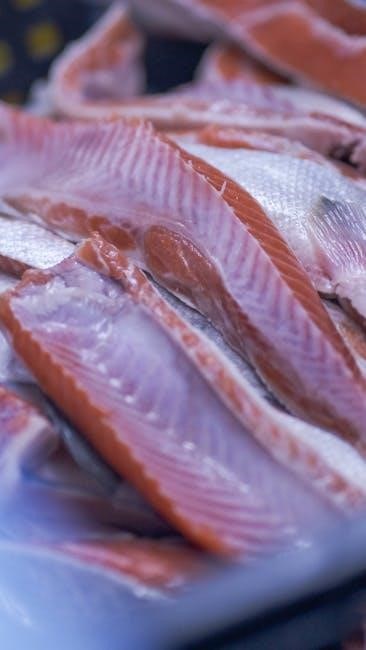
Social and Cultural Aspects
The pescatarian diet fosters community support and cultural adaptability, aligning with traditions that emphasize seafood and plant-based meals, making it a socially and culturally appealing choice.
8.1 Social Benefits of a Pescatarian Diet
The pescatarian diet encourages social bonding through shared meals and community support. It fosters connections with like-minded individuals, making it easier to maintain social connections while dining out or hosting gatherings. The flexibility of the diet allows for easy adaptation to various social settings, promoting a sense of belonging. Additionally, the emphasis on sustainable and ethical food choices aligns with cultural values, creating a positive social impact. This diet not only nourishes the body but also strengthens social ties, making it a lifestyle choice that resonates with many.
8.2 Cultural Influences on Pescatarian Diets
Cultural influences significantly shape pescatarian diets, reflecting regional ingredients and traditions. Coastal communities often emphasize fresh seafood, while Mediterranean and Asian cuisines incorporate fish and plant-based dishes. These cultural practices not only diversify meal options but also highlight sustainable eating. The pescatarian diet aligns with many cultural values, promoting a harmonious blend of tradition and modern dietary preferences. This cultural diversity enriches the pescatarian lifestyle, making it adaptable and globally appealing. By embracing these influences, individuals can enjoy a varied and culturally rich culinary experience while adhering to their dietary choices.
Environmental Impact
The pescatarian diet contributes to reducing carbon footprints by minimizing meat consumption and promoting sustainable seafood choices, fostering eco-friendly eating habits that support environmental conservation efforts.
9.1 Sustainability of Seafood Choices
Choosing sustainable seafood is crucial for maintaining healthy oceans and biodiversity. Opt for wild-caught fish and locally sourced options to reduce environmental impact. Certifications like MSC ensure responsible fishing practices. Avoid species high in mercury or overfished populations. Support eco-friendly aquaculture and seasonal catches to promote marine conservation. By making informed decisions, pescatarians can help preserve marine ecosystems while enjoying nutritional benefits.
9.2 Reducing Carbon Footprint
A pescatarian diet can significantly reduce your carbon footprint by minimizing reliance on meat production, which is a major contributor to greenhouse gas emissions. Seafood and fish generally require less land, water, and feed than livestock, making them more sustainable options. Choosing locally sourced and seasonal seafood further cuts down on transportation emissions. Additionally, avoiding processed foods reduces packaging waste and energy consumption. By embracing plant-based meals and sustainable seafood, pescatarians can contribute to a healthier planet while enjoying a balanced diet.

Cost-Effective Meal Planning
Planning a pescatarian diet can be cost-effective by incorporating affordable seafood like canned fish and frozen options, while avoiding processed foods to save money and maintain nutrition.
10.1 Budget-Friendly Seafood Options
Budget-friendly seafood options include affordable choices like canned tuna, salmon, and sardines, which are rich in protein and omega-3s. Frozen shrimp, tilapia, and mussels are also cost-effective and versatile for meals. Purchasing seafood in bulk or during sales can reduce costs. Additionally, shellfish like clams and oysters are often priced lower than finfish. Incorporating these options into meal plans ensures a nutritious and affordable pescatarian diet without sacrificing flavor or variety. Balancing seafood with plant-based ingredients further enhances cost-efficiency while maintaining nutritional balance.
10.2 Reducing Food Waste
Reducing food waste is crucial for a cost-effective pescatarian diet. Plan meals around fresh ingredients and use leftovers creatively. Freeze surplus seafood and vegetables to extend their shelf life. Composting food scraps helps minimize landfill waste. Shopping with a list ensures only necessary items are bought. Using up every edible part of ingredients, like fish heads for broth, further reduces waste. These practices not only save money but also contribute to a more sustainable lifestyle, making the pescatarian diet both environmentally friendly and budget-conscious.
Staying Motivated
Staying motivated on a pescatarian diet involves setting achievable goals, celebrating progress, and embracing the health and environmental benefits of your choices, fostering long-term commitment and satisfaction.
11.1 Setting Realistic Goals
Setting realistic goals is crucial for maintaining motivation on a pescatarian diet. Start by gradually incorporating more plant-based and seafood meals while reducing meat consumption. Break down larger objectives into smaller, manageable tasks, such as meal prepping or exploring new recipes weekly. Celebrate milestones, like completing a meat-free week, to stay encouraged. Tracking progress in a journal can also help visualize achievements and maintain accountability. Adjust goals as needed to ensure they remain attainable and aligned with your lifestyle, fostering a sustainable transition to the pescatarian diet.
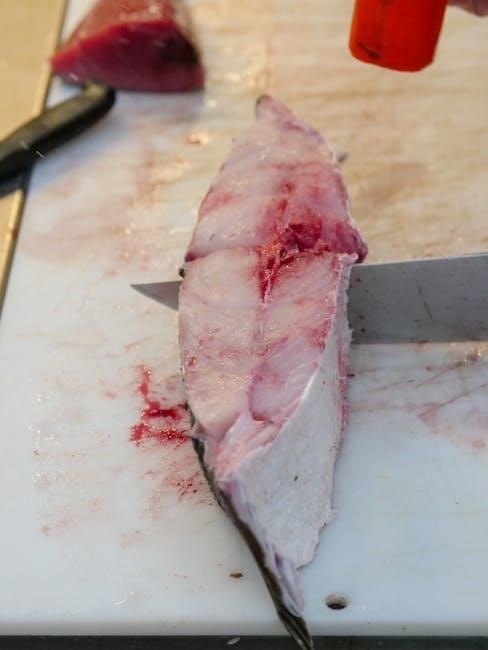
11.2 Building a Supportive Community
Building a supportive community is essential for long-term success on a pescatarian diet. Join online forums, social media groups, or local meetups to connect with like-minded individuals. Sharing experiences and tips can foster motivation and accountability. Participate in cooking challenges or potluck events to explore new recipes and gain inspiration. A supportive network can help address challenges and celebrate progress, making the transition to a pescatarian lifestyle more enjoyable and sustainable. Surrounding yourself with others who share your dietary goals creates a positive environment for growth and encouragement.
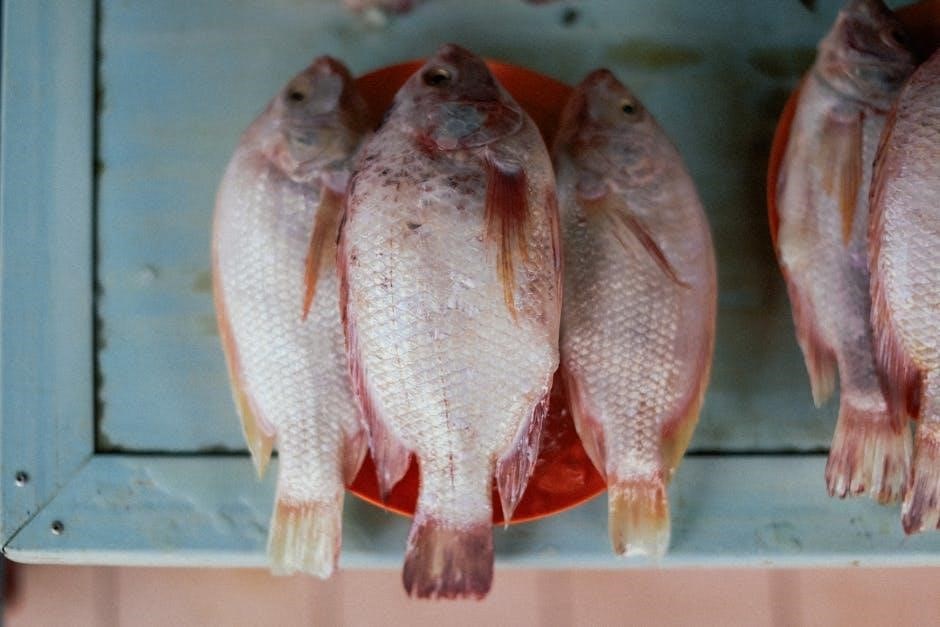
Common Challenges

Transitioning to a pescatarian diet often involves overcoming cravings for meat and navigating social pressures. Planning balanced meals and seeking support can help address these challenges effectively.
12.1 Overcoming Cravings for Meat
Cravings for meat are common when transitioning to a pescatarian diet. To overcome this, focus on incorporating flavorful seafood and plant-based alternatives. Try marinated tofu or grilled portobello mushrooms for hearty, meat-like textures. Increasing umami flavors with ingredients like soy sauce or mushrooms can also satisfy cravings. Additionally, meal prepping and snacking on protein-rich foods can help maintain satisfaction and reduce the urge for meat. Staying hydrated and ensuring adequate nutrition can further curb unwanted cravings, making the transition smoother and more sustainable.
12.2 Handling Social Pressures
Adopting a pescatarian diet can sometimes lead to social pressures, especially in meat-centric cultures. To navigate this, communicate your choices clearly and offer alternatives when dining with others. Suggest restaurants with pescatarian-friendly options or bring a dish to share. Educating others about the benefits of your diet can also reduce misunderstandings. Staying confident and informed about your choices will help you thrive socially while maintaining your dietary preferences. Building a supportive community, whether online or in person, can further ease the transition and provide encouragement when facing challenges.
The pescatarian diet is a great choice for those seeking a balanced lifestyle. It offers health benefits, supports environmental sustainability, and provides flexible meal options. Start your journey with a pescatarian diet plan today!
13.1 Final Thoughts on the Pescatarian Diet
The pescatarian diet offers a balanced and sustainable approach to nutrition, combining the health benefits of seafood with the environmental advantages of reducing meat consumption. It provides a variety of meal options, making it easy to incorporate into daily life. By focusing on seafood, plant-based foods, and dairy, this diet supports overall well-being while promoting eco-friendly choices. For those looking to adopt a lifestyle that aligns with their health and environmental values, the pescatarian diet is a practical and rewarding option. Start your journey with a well-planned pescatarian diet plan today!
13.2 Next Steps for Adopting the Diet
To begin your pescatarian journey, start by planning balanced meals using a pescatarian diet plan. Incorporate seafood, plant-based foods, and dairy while avoiding meat. Focus on sustainable seafood choices to support environmental health. Gradually transition by substituting meat with fish or vegetarian options in familiar recipes. Set realistic goals, like reducing meat intake weekly, and explore new flavors to keep meals exciting. Engage with online communities or cookbooks for inspiration. Track your progress and adjust as needed to ensure a smooth and enjoyable transition to this healthier, more sustainable lifestyle.
